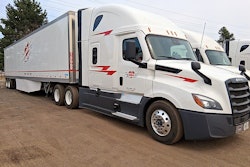U.S. Transportation Secretary Mary E. Peters on Wednesday, Oct. 17, joined with U.S. Commerce Secretary Carlos Gutierrez and Mexican Transportation Secretary Luis Tellez in calling on Congress to reconsider its pending prohibition and let the cross-border trucking demonstration program between the two nations proceed.
“With the change of just a few words, Congress can show that we can trade with the world, keep our highways safe, and our companies competitive at the same time,” Peters said.
In September, the Department of Transportation began a cross-border trucking demonstration project that will allow up to 100 U.S. trucking companies to operate in Mexico and up to 100 Mexican trucking companies to operate beyond commercial zones in the United States. The future of the program is in jeopardy due to pending legislation that would cut off federal funds for the demonstration.
“We want to demonstrate to Congress that tough safety standards and rigorous inspections work, and that trucks participating in this program will have the same features, the same upkeep and the same commitment to safety that any U.S. truck has,” Peters said.
To support her argument, Peters invited a Maryland state trooper to conduct a safety inspection of two trucks participating in the cross-border trucking demonstration — one a U.S. truck, and the other the first Mexican truck to make a U.S. delivery as part of the demonstration. The trucks are virtually identical, Peters said, because both trucks must meet the same strict U.S. safety standards.
Peters said Congress has spent $500 million since 1994 to prepare for the start of cross-border trucking, funding hundreds of highly-trained inspectors, dozens of state-of-the art facilities and rigorous new requirements to ensure every truck, every company and every driver from Mexico that participates in the program meets every U.S. safety standard without exceptions.
While critics of the program — including the Owner-Operator Independent Drivers Association, the Teamsters union and a number of members of Congress — have raised safety concerns about Mexican trucks, the Federal Motor Carrier Safety Administration argues that thousands of Mexican trucks already operate every day in U.S. cities such as San Diego and El Paso, Texas. In 2006 alone, Mexican trucks crossed into the United States 4 million times, while no U.S. trucks were allowed to enter Mexico. For years, however, those Mexican trucks have been limited to the 25-mile border commercial zone within the United States.
The fiscal year began Oct. 1, and the House and Senate have yet to pass a consensus version of the DOT appropriations bill. Congress passed a so-called continuing resolution that provides federal funding through Nov. 16 while lawmakers resolve differences on the various appropriations bills.
“I ask Congress to listen to the facts about the safety of this program, not the fiction being spread by a few, and to continue giving U.S. truck drivers the chance to compete in Mexico and U.S. consumers the opportunity to save,” Peters said.
OOIDA and the Teamsters both were quick to dismiss Wednesday’s truck inspection as nothing more than a publicity stunt. “Akin to a magician’s pretty assistant distracting an audience from what he is up to, this is just another attempt by DOT to divert attention away from the program’s deficiencies,” said OOIDA Executive Vice President Todd Spencer. “It’s a sleight of hand that shows nothing. There are very real safety and security problems that still exist.”
Peters showed contempt for Americans’ intelligence with the inspection stunt, said Teamsters General President Jim Hoffa, who added that Peters’ effort to promote the viability of the program is ridiculous. “Does the Bush administration think we’re stupid?” Hoffa said. “It’s insulting to the intelligence of the American people to suggest that a staged truck inspection before the news media proves anything.”









